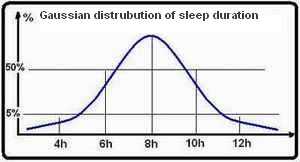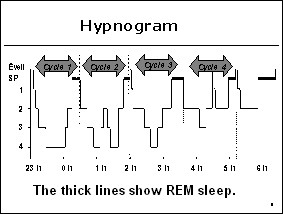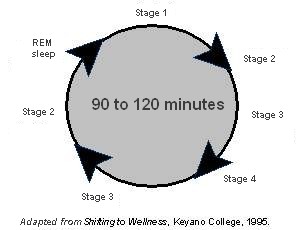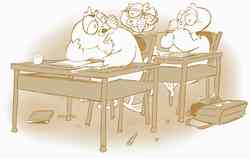Home > Welcome > Sleep-wake pathologies > Know how to sleep > Know how to sleep
Know how to sleep
Wednesday 10 October 2007
All the versions of this article: [English] [français] [svenska]
"35 or 45 hours a week? "
Sleep duration is not, alone, a sufficient criterion to judge its quality and efficiency.
There are four key points to understand... to know how to sleep :

- 30% sleepers are outside average (6 to 9 hours)


- Sofres survey (for the ISV), 2004
Sleep duration is one of the greatest physiological variables of the human species. It can (normally) be comprised between 4 and 12 hours in 24.
Sleep is not homogenic (Cf. "Iconography / Sleep characteristics").

- Hypnogram (4 cycles)
It is made of a succession of cycles, each made of phases of sleep described as « slow » (deeper and deeper) and REM sleep (often with dreaming). (Cf. "Normal and pathological hypnograms").

- The duration of each cycle is a constant
Slow deep sleep occupies most of the time of the first cycles (the first half of the night).
REM sleep predominates during the last cycles (sleep of the morning) (when the pressure of slow deep sleep decreases).
REM sleep duration is in accordance with the body temperature.

- Sleep cycles
The length of each cycle (slow + REM sleep) is, on the other hand, a constant that is specific to each species. It correlates with the level of energetic expense (basal metabolism) of the brain. [1]
In man, the cycles of REM sleep repeat themselves circa every 90 minutes (1 hour and 30 minutes) and it occupies 25% of the total sleep time. (That ratio of 1/4 is a constant amongst all mammals).
According to each person’s needs, a night of sleep is composed of (in average) 4 to 6 sleep cycles (six to nine hours).
Chronobiology: the "dietetics" of sleep ...
In the last century, the knowledge about food balance has gone from the concept of the amount of food to that of [nutritional quality.
Since a short while, the concept of "alicaments" (a French word made up of “aliment” = food and “médicament” = medication. The neologism “somnication” follows the same logic.) appeared, food which function is not only nutritional but therapeutic as well.
In the same way, the neologism "Somnication" will be useful to describe the main exterior elements that take part in the alternation of the sleep/wake cycle.
Our knowledge about sleep has made huge progress, too. The concept of sleep efficiency, of the amount of slow deep sleep; of amount, latency and density of rapid eye movements in REM sleep; the number of spindles, of "K complexes", of transition phases and so on.... supplants the notion, far too limited, of sleep duration. Cf. "Sleep characteristics"

- Microstructure of sleep
Starting from these modern concepts, it is possible to make out a few new principles of sleep dietetics which must become a base for every therapeutic approach :
Their generalization could have a much higher impact on public health than the best current medical prevention campaign :
* Sleepiness is the first cause of work and traffic accidents.
Sleep deprivation is harmful at all levels of the organism.
Sleep apneas have serious metabolic and cardio-vascular consequences.
*Tiredness is the main cause of consultation which gives rise to repeated dangerous complementary explorations (iatrogenic risk).
It leads to the vicious circle of insomnia and its medicine induced consequences (sleepiness...).
All in all ...the direct and indirect consequences of the sleep disorders are probably heavier than those of the cardio-vascular diseases or of cancer which receive all the attention of the Authorities.
Four key points ..:
- It is the mechanisms of arousal which produce the chemical mediators in charge of sleep, all over the day.
"It is not a small thing to be able to sleep: one must wake all day to be able to sleep well" the wise man tells to Zarathustra.
"Currently, the emphasis is put on the importance of wake in sleep regulation. The broadest diffusion of that way to see sleep should carry along a significant reduction of the prescription of many psycho-active drugs used as sleeping pills.". Pr. JL Valatx, in "La Revue du Praticien"; Paris; 1996) .
Calm sleep (slow wave sleep) and REM sleep (fast waves) are, each, the result of the functioning of two distinct networks in the brain:
- An executive network, that can be compared to a pacemaker (a clock), in charge of the sleep phenomenon (alternation of the cycles, deepness of sleep);
- And a permissive network which controls the triggering of sleep. Falling asleep is the consequence of the blocking out of arousal by an anti-arousal system. That permissive neurons network of sleep is activated by the neurons of arousal.That mode of regulation allows to comprehend insomnias as arousal disorders pertaining to a new therapeutic approach.
In other words, the wise man was right : one must have been awake during the day to sleep well during the night.In practice :
The consequence of what came before is that all the substances which diminish the quality of arousal (tranquillizers, alcohol...) slow down the synthesis of the sleep mediators.
Because of that, the remaining effect of the sleeping pills during the day contributes to degrade nocturnal sleep the following night by degrading arousal in a true vicious circle.
One should never use a sleeping pill without being aware of that paradox. The insomniac subject is convinced that he/she sleeps "thanks to" a drug which, in fact, deeply disturbs his/her sleep and diurnal performances. - Sleep is regulated by biological clocks and cannot be commanded by will
It is useless to want to sleep when one is not sleepy. ("The silent thief must not be called because he runs away playing the horn." (Zarathustra)
Our nights’ clock is situated in the thalamus, in the centre of the brain. It synchronizes all the cells of the organism on a circadian rhythm.
That internal system is objectively observed by measuring the concentration of several hormones (e.g. melatonin and cortisol during the night, growth hormone in the morning).

- Coutesy of "lecerveau-mcgill.ca"
The circadian rythmicity is already present at the cell’s level. The nucleus of an isolated cell will continue to synthesize a feed back regulated protein on a 24 hours period.
The gene (called Clock"), which controls the duration of the cycle, has been discovered very recently (in 2003) in mice. The genetic manipulation of that gene produces mice of which the organism (like each of its cells) presents a 28 hours rhythm.Even at a propitious time for falling asleep, the "train of sleep" comes only every 30 or 40 minutes.
- Sleepiness occurs in successive waves. Just like for many other physiological needs (like emptying one’s bladder), a neural excitement reaction will happen if one resists to an attack of sleepiness, which will block out the mechanisms of sleepiness for a while.
- Tiredness is the physical sensation of having to stop immediately. It is an alarm signal which, by definition, resists the will to continue. .The problem of chronic insomnia is that the sick person, who is often tired from when he/she wakes up, suffers such a strain from fear not to be able to manage to fall asleep, that the more he/she tries to sleep, the more he/she wakes up (motivation and fear are feelings which are able to wake up any sleepy subject!).
It is just as illusory to want to sleep without being sleepy as to want to decide to be hungry after a meal. (Worse, in fact, because wanting to sleep has an arousing effect). - The brain is just as active during sleep as during wake
The brain never sleeps, (the lights stays on behind the blinds of sleep.)
It can logically be concluded from that, that all the substances which inhibit cerebral activity have a harmful effect on the quality and the efficiency of sleep.
In fact, sleeping pills must paradoxically be considered like drugs with an anti-sleep effect. The sleeper is in a state of "non-arousal" (caused by the inhibition of the systems of arousal) but he/she is just as well in a state of "non-sleep", like the sleep recordings under the effect of sleeping pills.
NB: The EEG tracé of the sleeper under treatment shows a quick rhythm, called "medicine induced sleep", where a fall of slow sleep is measured, which looks just like the worst insomniac’s sleep pattern.

- It is obvious that the NAP must be used with special precautions.
They are summarized here in the "DiDal pro-Smg of the "somnication".
Also read the "general public" sheet : Indications, contraindications, dosage...
As a general rule, the nap should always be short and fit the circumstances.

- Adapted from Gerry Wyder
Practical consequences :
The understanding of the chronobiological mechanisms which govern the sleep-wake rhythm (see "Have to sleep") leads to the stipulation of general rules.
These generalities cannot be applied to everyone with the same degree of importance because each sleeper is a particular case.
"A good sleeper goes to sleep trusfully and wake up healthy" whatever his/her sleep rhythm might be.
In other words, even if it is true that chocolate, chips or sodas are fattening, ... some "big eaters" will always stay slim and some "unlucky people" will have to keep control.
There exist great inter-individual inequalities in the field (of the energetic balance) and some subjects are compelled to "be careful not to take on weight".
NB: Orexin (or hypocretin) is a common hormone to the regulation of sleep and appetite, inside the same regulation system (the endoCB system). Thus, sleep disorders and obesity could match a common deregulation of an immune kind on a genetically favouring ground.
(To be continued...)
Still, there are general rules which have to be known in order to "know how to sleep" and adapt thereby to the constraints of the modern world.
Also read the other articles related to "know how to sleep" :
- General advice to the insomniacs...
- Learn to sleep
- The "somnications"
- Relaxation techniques
- Risks of the new sleeping pills
- Alcohol, drugs, sleeping pills ...
"Know how to sleep" : the chronobiological adaptation to the imposed rhythms :
- Sleep from the infant to the teenager ...
- night and shift work...
- Jet lag, the phase shift of the traveller...
- Sleep and sport...
"Want to sleep", the problematic of insomnia :

- More information...
- Pr Jean Louis Valatx: Mechanisms of the wake-sleep-dream cycle (La Revue du Praticien (Paris) 1996; 46: 2404-10) (In French)
- "Dreaming" in animals (Mehdi Tafti , Science et Avenir Hors-Série Le Rêve Dec. 96) (In French)
- Bestiaire du sommeil (Mehdi Tafti , Science et Avenir Hors-Série Le Rêve Dec. 96)
[1] The occurrence of REM sleep is a constant, very specific to each animal species : it shows up roughly every 4 minutes during a mouse’s sleep, every 12 minutes in the squirrel, every 27 minutes in the cat, every 60 minutes in the horse, every 90 minutes in man and every 100 minutes in the elephant.
Back to text
